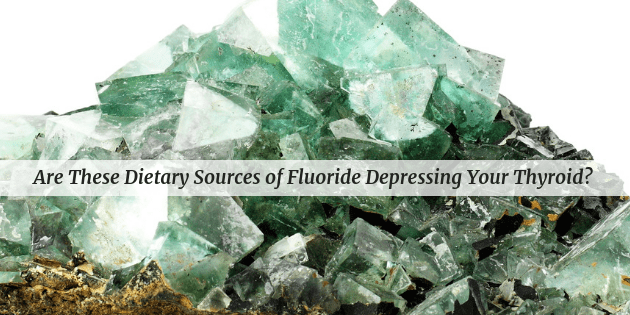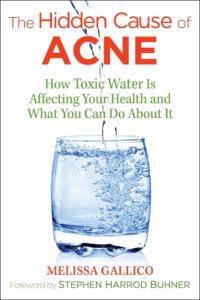Today’s guest post is by my friend Melissa Gallico. She addresses the dangers of fluoride and fluoridated water and possible dietary sources of fluoride that may be causing low thyroid function.
→Be sure to check out “About the Author” below.
Topics which will be discussed include:
- Dietary Sources of Fluoride and Low-Thyroid Function
- Melissa’s Personal Health Crisis
- Five Common Sources of Toxic Fluoride Exposure
- Five Steps to Eliminate Dietary Sources of Fluoride
Over 70% of public water supplies in the United States are artificially fluoridated. The Centers for Disease Control (CDC) recommends the addition of fluoride as a way of reducing the rate of cavities in the general population, but fluoride affects more than just teeth.
Given the epidemic rate of thyroid disorders, you might be surprised to hear that a chemical indiscriminately added to public water supplies in cities throughout the United States—as well as several other countries including Canada, Australia, New Zealand, England, Ireland, and Brazil—is a known thyroid depressant.
Until the 1950s, many doctors used fluoride as a treatment to lower thyroid activity in patients with overactive thyroid glands.¹ A dose as low as 2 to 5 milligrams per day over a period of a few months was enough to decrease thyroid activity in their patients.
This is the same amount of fluoride many people consume on a daily basis, especially if they live in a town where the public water supply is artificially fluoridated.
A Reluctant Expert on Dietary Sources of Fluoride
Fluoride is a controversial topic for a lot of people. Government authorities insist there are no negative side effects to adding fluoride to public water supplies at the dose they deem optimal, but they also have a history of underestimating the longterm effects of certain chemicals when a large financial interest is at stake—especially natural contaminants like lead, mercury, and fluoride.
I did not question fluoridation until I had the experience of living in several non-fluoridated countries and saw firsthand the dramatic effect it had on my health. The most obvious difference was the disappearance of the chronic cystic acne that plagued me anytime I lived in fluoridated cities in the United States.

Melissa Gallico Before Pics
(Cystic Acne)
Fluoride-induced acne is not an uncommon condition, but few people know about it because fluoride sneaks into our daily lives in unexpected ways. Once I identified dietary fluoride as the root cause of my acne, I was able to heal my skin completely by learning how to avoid excess fluoride in my food and water.
More subtle effects included a lifting of the chronic depression I had come to think of as normal and an overall improvement in mental clarity and emotional health.
5 Common Sources of Toxic Fluoride Exposure
I learned about many of these dietary sources of fluoride the hard way, through trial and error on my skin. To save you time, here is a list of the top 5 sources of fluoride exposure in modern life:
- Fluoridated water
Over 90% of the fluoride added to public water supplies in the United States is fluorosilicic acid (FSA), a toxic byproduct of the phosphate fertilizer industry.² The pollution story behind fluoridation is one of several reasons why the negative health effects of fluoride have been historically neglected.³ - Food and beverage made with fluoridated water
Soft drinks and other ready-to-drink beverages will contain fluoride if they are manufactured with fluoridated water. Similarly, foods such as rice and pasta will contain fluoride if they are cooked in fluoridated water. Even boxed breakfast cereals can contain significant amounts of fluoride because of the way fluoride concentrates in the finished product if the manufacturing plant uses fluoridated water for processing. (4) - Tea
The camellia sinensis plant is virtually the only edible plant that uptakes significant amounts of fluoride directly from the soil. Because fluoride bioaccumulates in bone tissue, heavy tea drinkers have been known to develop symptoms of arthritis due to its high fluoride content, a condition known as skeletal fluorosis. (5) - Fluoride-based pesticides
In 1989, European importers noticed high amounts of fluoride in the California wine they were importing. This is because a fluoride-based pesticide called cryolite is commonly used on grape crops in California. Grape products from this region—including juices, raisins, and wine—can be a significant source of fluoride. Cryolite is not used on vineyards in Oregon or Washington state. According to regulations set by the EPA, the limit for fluoride pesticide residue on animal feed is 130 ppm (for comparison purposes, the recommended amount of fluoride in drinking water is 0.7 ppm). As with humans, fluoride accumulates in the bones of chickens when they consume it in their diet. This is why non-organic poultry products are high in fluoride, especially ground poultry, lunchmeat, chicken nuggets, soup and other items where bone residue is contained in the final product. (6) - Fluorinated chemicals used in manufacturing
Fluorinated chemicals make their way into food cooked in non-stick cookware like Teflon. It is also a common ingredient in many pharmaceuticals, including Prozac, Paxil, Cipro, Flonase, and Lipitor to name just a few.
5 Steps for Eliminating Dietary Sources of Fluoride
The long-term solution to chronic fluoride intoxication is to end the obsolete practice of adding fluoride to public water supplies. (Click here to sign my petition to end fluoridation). In the meantime, here are five steps you can take today to lower your exposure to this dangerous chemical.
- Find a source of drinking water that is low in fluoride
To find out if your water supply is fluoridated, ask your local water provider for their annual “Consumer Confidence Report” or search for it online. Look for a fluoride level close to the mean fluoride content of freshwater which is 0.05 ppm. (The amount currently recommended by the CDC is fourteen times this amount.) Reverse osmosis filters are effective at removing fluoride. - Eat organic
Purchase organic food when possible, but especially when it comes to grape products and poultry. - Drink herbal tea
Switch from traditional black tea to herbal alternatives, such as peppermint, raspberry leaf, or yerba mate. - Use fluoride-free cookware
Upgrade any fluorinated non-stick cookware to quality ceramic, stainless steel, or cast iron. - Work with a naturopath or functional medicine practitioner to safely discontinue the use of fluoride-based pharmaceuticals
Going off certain medications can be dangerous. If you are discontinuing the use of a fluorinated pharmaceutical, consult a knowledgeable naturopath or functional medicine practitioner to help you through it. For a listing of fluorinated pharmaceuticals, visit http://www.slweb.org/ftrcfluorinatedpharm.html.
References
- Galletti, Pierre M., and Gustave Joyet. 1958. “Effect of Fluorine on Thyroidal Iodine Metabolism in Hyperthyroidism.” Journal of Clinical Endocrinology 18:1102–10,
https://www.ncbi.nlm.nih.gov/pubmed/13587625 - Center for Disease Control, “Water Fluoridation Additives,” accessed October 11, 2018
https://www.cdc.gov/fluoridation/engineering/wfadditives.htm - Connett, Paul, James Beck, and H. S. Micklem. 2010. The Case Against Fluoride. White River Junction, Vt.: Chelsea Green Publishing.
- Da Silva Cardoa, Vanessa Eid et al. 2003. “Fluoride content of several breakfast cereals and snacks found in Brazil.” Journal of Applied Oral Science 11 (4)
http://www.scielo.br/scielo.php?script=sci_arttext&pid=S1678-77572003000400006 - Godfrey, Michael. 2018. “A Case of Skeletal Fluorosis?” New Zealand Medical Journal 131 (1474)
https://www.nzma.org.nz/journal/read-the-journal/all-issues/2010-2019/2018/vol-131-no-1474-4-may-2018/7561 - Fein, Noelle J., and Florian L. Cerklewski. 2001. “Fluoride Content of Foods Made with Mechanically Separated Chicken.” Journal of Agricultural and Food Chemistry 49 (9): 4284–86
https://www.ncbi.nlm.nih.gov/pubmed/11559124
Links for more information:
- F Is for Fluoride: A Feasible Fairytale for Freethinkers 15 and Up
https://www.amazon.com/Fluoride-Feasible-Fairytale-Freethinkers-15/dp/1732402205/ - The Hidden Cause of Acne: How Toxic Water is Affecting Your Health and What You Can Do About It
https://www.amazon.com/Hidden-Cause-Acne-Affecting-Health/dp/1620557096/ - A new study just released: Fluoride’s effects on thyroid health
Link to the study:
https://www.sciencedirect.com/science/article/pii/S016041201830833X
Link to the news article:
https://www.ehn.org/we-add-it-to-drinking-water-for-our-teeth-but-is-fluoride-hurting-us-2611193177.html - Petition to end fluoridation
https://www.change.org/p/congress-stop-promoting-fluoridation - List of fluorinated pharmaceuticals
http://www.slweb.org/ftrcfluorinatedpharm.html - The Hidden Cause of Acne
www.HiddenCauseofAcne.com - My website to end fluoridation
www.ProjectFree.Me
About the Author

For a free cheat sheet on the hidden source of fluoride, subscribe to Melissa Gallico’s newsletter at www.HiddenCauseofAcne.com.
My website to end fluoridation: www.ProjectFree.Me
Get Your Copy of Melissa’s Book:




Leave A Response